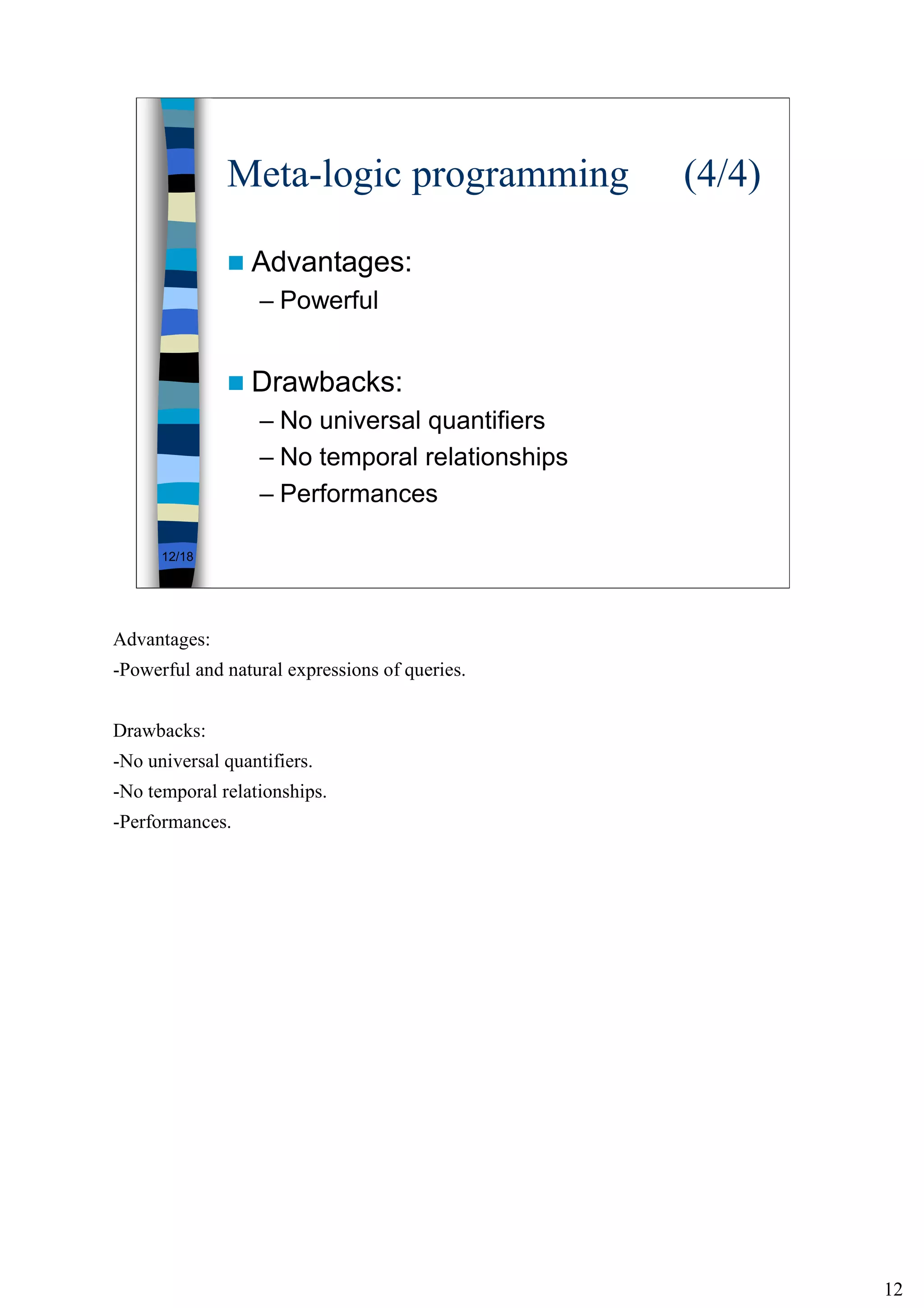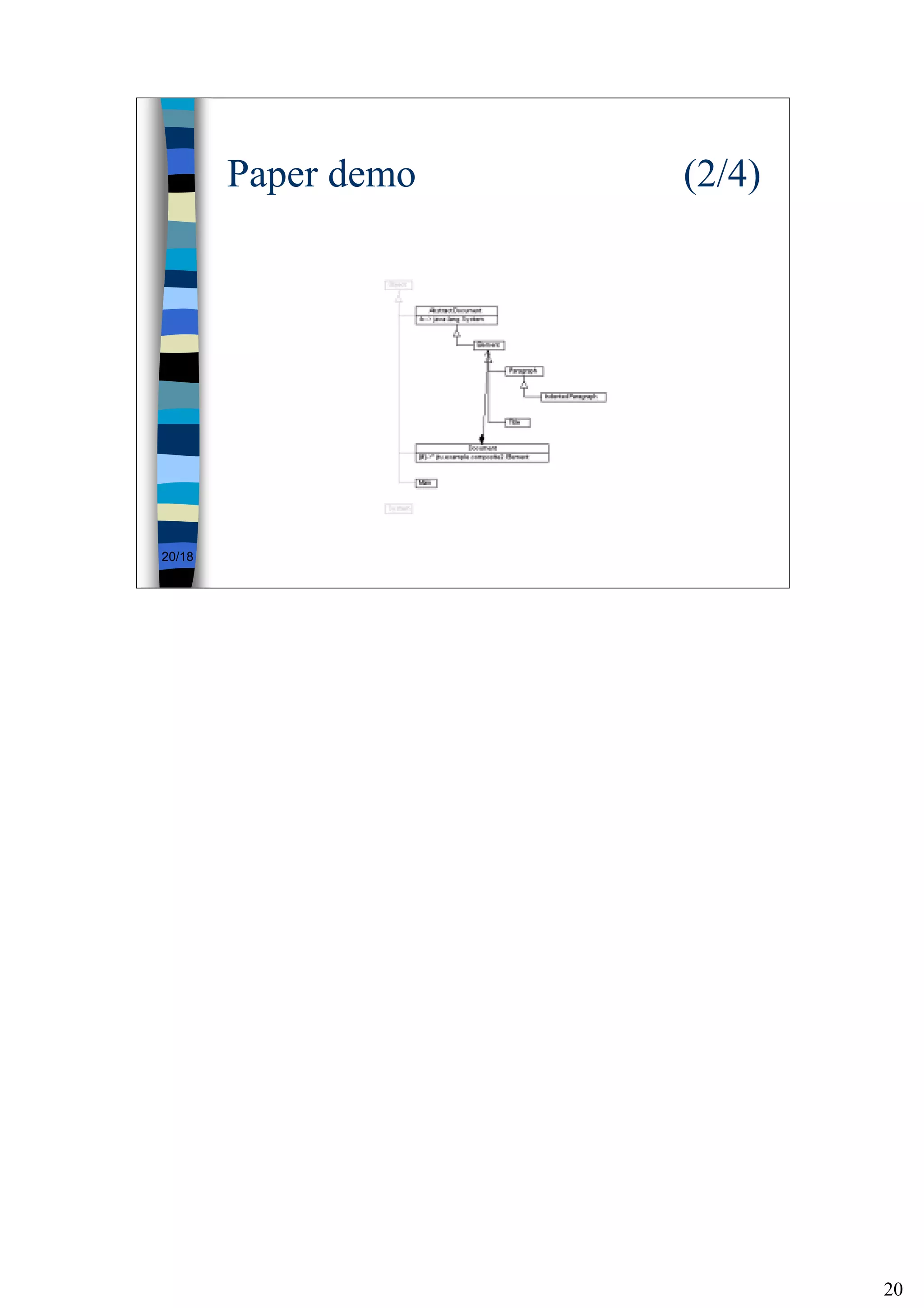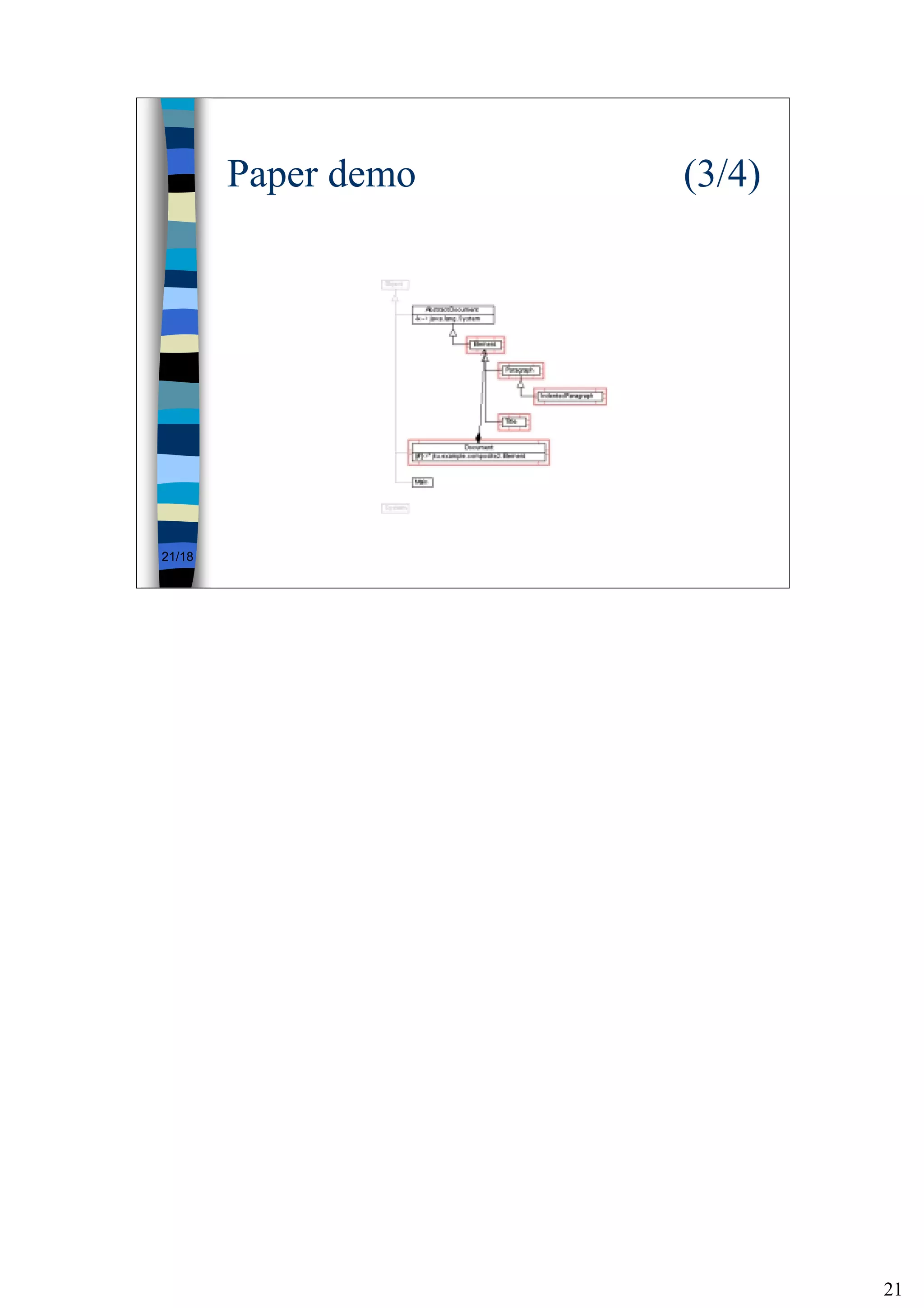The document presents three declarative meta-programming techniques: meta-modelling, meta-logic programming, and explanation-based constraint programming, applied to design patterns and defects. It discusses their use in pattern description, application, and detection, highlighting advantages and drawbacks for each technique. The concluding part emphasizes the integration of these methods into the tool Ptidej for enhanced analysis and pattern identification in Java programs.



![4
4/18
Context of our research
Design patterns
⇒ Design defects
⇒ Patterns
Patterns description
Pattern application
(design patterns only! ☺)
Pattern detection
We work on design patterns and design defects.
Design patterns are “descriptions of communicating objects and classes that are
customized to solve a general design problem in a particular context” ([Gamma, 1994],
page 3).
Design patterns describe a problem, a solution, and the consequences when applying the
solutions.
The solution of a design pattern is generally represented with OMT diagrams and source
code examples; That is the solution of a design pattern is generally represented with a
micro-architecture exemplifying the solution.
We argue that:
-Design defects are similar to design patterns and we can represent them as design
patterns.
-A micro-architecture close but not identical to the solution of a design pattern represent
a possible design defects.
We call design patterns and design defect “patterns”.
We want to describe patterns (the micro-architectures representing the solutions of
design patterns, or representing design defects).
We want to apply design patterns from descriptions of design patterns.
We want to detect complete forms of design patterns, distorted forms of design patterns,
and design defects.](https://image.slidesharecdn.com/ase02dmp-171207035356/75/Ase02-dmp-ppt-4-2048.jpg)

![6
6/18
Meta-modelling (2/4)
Translates into
Informal descriptions
from [Gamma, 1994]
Instance of Interface
Instance of Class
Instance of Association
Instance of Delegation
name() Instance of Method
Instance of Pattern
Here is a simple example of an abstract model.
This abstract model describes the Composite design pattern.
We describe the micro-architecture solution advocated by the Composite design pattern
and the informal information using constituents of the meta-model.](https://image.slidesharecdn.com/ase02dmp-171207035356/75/Ase02-dmp-ppt-6-2048.jpg)
![7
7/18
Meta-modelling (3/4)
public Composite() throws
CloneNotSupportedException,
PatternDeclarationException {
super();
final Class aClass;
final Interface anInterface;
final DelegatingMethod aDelegatingMethod;
final Method abMethod;
// Interface Component.
anInterface = new Interface("Component");
this.addEntity(anInterface);
abMethod = new Method("Operation");
anInterface.addElement(abMethod);
// Association children.
final Composition aComposition =
new Composition("children", anInterface, 2);
// Class Composite.
aClass = new Class("Composite");
this.addEntity(aClass);
aClass.addImplementedEntity(anInterface);
aClass.addElement(aComposition);
aDelegatingMethod = new DelegatingMethod(
"Operation",
aComposition);
aDelegatingMethod.attachTo(abMethod);
aClass.addElement(aDelegatingMethod);
// Class Leaf.
this.addLeaf(new String[] { "Leaf" });
}
Here is the source code describing the Composite design pattern.
It is declarative because each abstract model is declared by a sequence of statements.
It is meta because the statements are instances of constituents of the meta-model.
It is programming because we use the abstract model programmatically to reason about
the design pattern solution.](https://image.slidesharecdn.com/ase02dmp-171207035356/75/Ase02-dmp-ppt-7-2048.jpg)






![14
14/18
Explanation-based constraint
programming (2/4)
[ac4ProblemForCompositePattern() : PtidejProblem ->
let pb := makePtidejProblem("Composite Pattern Problem", length(listOfEntities), 90),
compositeRoot := makePtidejIntVar(pb, "CompositeRoot", 1, length(listOfEntities)),
component := makePtidejIntVar(pb, "Component", 1, length(listOfEntities)),
composite := makePtidejIntVar(pb, "Composite", 1, length(listOfEntities), false),
leaf := makePtidejIntVar(pb, "Leaf", 1, length(listOfEntities), false) in (
post(pb, makeCompositionAC4Constraint("CompositeRoot <>--> Component", "...", compositeRoot, component), 90),
post(pb, makeInheritanceAC4Constraint("CompositeRoot -|>- Component", "...", compositeRoot, component), 60),
post(pb, makeInheritanceAC4Constraint("Composite -|>- CompositeRoot", "...", composite, compositeRoot), 90),
post(pb, makeInheritancePathAC4Constraint("Leaf -|>- ... -|>- Component", "", leaf, component), 90),
post(pb, makeIgnoranceAC4Constraint("Component -/--> Leaf", "...", component, leaf), 10),
post(pb, makeIgnoranceAC4Constraint("Leaf -/--> Composite", "...", leaf, composite), 30),
post(pb, makeNotEqualAC4Constraint("Component <> Leaf", "...", component, leaf), 100),
post(pb, makeNotEqualAC4Constraint("Composite <> Leaf", "...", composite, leaf), 100),
post(pb, makeNotEqualAC4Constraint("CompositeRoot <> Leaf", "...", compositeRoot, leaf), 100),
pb
)
]
Here is an example of the constraint system we use to detect complete and distorted
micro-architecture identical or similar to the Composite design pattern.
This constraint system is directly obtained from the abstract model of the Composite
design pattern.
First, we declare the problem.
Then, we declare the different variables.
Each variable represents an actor in the pattern.
In particular, the Composite and Leaf actor are declared as not enumerated, because their
roles may be filled by more than one entity in the software architecture.
Finally, we post the different constraints representing the Composite design pattern.
We associate a weight with each constraint to tell the Ptidej Solver which constraints it
can relax and which it can not.
It is declarative because the constraint system is declared by a sequence of constraints.
It is meta because the constraints apply on the architecture of the program.
It is programming because we use constraint systems programmatically to detect
complete and distorted forms of design patterns.](https://image.slidesharecdn.com/ase02dmp-171207035356/75/Ase02-dmp-ppt-14-2048.jpg)







